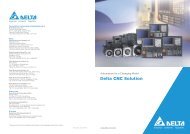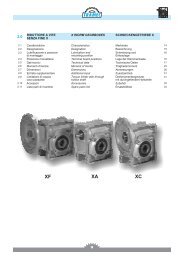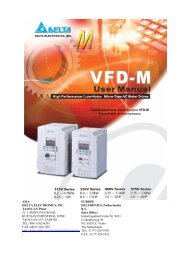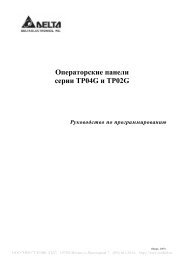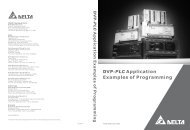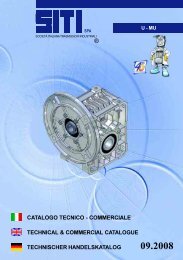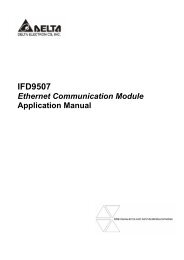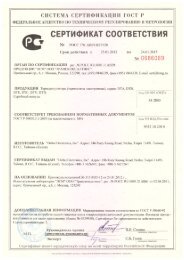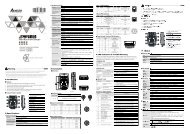Medium Voltage Application Guide
Medium Voltage Application Guide
Medium Voltage Application Guide
You also want an ePaper? Increase the reach of your titles
YUMPU automatically turns print PDFs into web optimized ePapers that Google loves.
SWITCHGEAR<br />
Interlock scheme 1: Two incomers and bus coupler interlocking<br />
The two incomers and the bus coupler circuit breakers use a standard "2 out of 3" interlocking system to prevent a<br />
parallel feed from the two incomers onto a common bus. Interlocking allows the following conditions:<br />
1. The two incomer circuit breakers closed (Q-1L and Q-1R ) with the bus coupler circuit breaker open (Q-BC).<br />
2. Left incomer and bus coupler circuit breakers closed (Q-IL and Q-BC) with right incomer circuit breaker open<br />
(Q-IR).<br />
3. Right incomer and bus coupler circuit breakers closed (Q-IR and Q-BC) with left incomer circuit breaker open<br />
(Q-IL).<br />
Typically, these interlocking conditions are met using both a mechanical and electrical method.<br />
Mechanical interlocking<br />
Interlocking uses a key system which includes 3 identical locks and 2 identical keys.<br />
Both incomer and the bus coupler circuit breakers (Q-IL, Q-IR, Q-BC) require an interlock key to be inserted into<br />
the circuit breaker body, and the circuit breaker racked into the service position, before the circuit breaker can be<br />
closed. This interlock key can only be removed when the circuit breaker is open and in the racked-out test position.<br />
When the circuit breaker is in service, the interlock key is not accessible.<br />
Both incomer and the bus coupler circuit breakers (Q-IL, Q-IR, Q-BC) are fitted with identical locks but only two<br />
matching keys are available.<br />
Under normal operating conditions, the two incomer circuit breakers are closed using the two available interlock<br />
keys. The bus coupler circuit breaker is not permitted to close. If one of the incomer supplies is lost, the associated<br />
circuit breaker is opened and racked-out to the test position. The interlock key can be moved to the bus coupler<br />
circuit breaker, allowing it to be racked into the service position and closed. When normal supply resumes, the bus<br />
coupler circuit breaker has to be opened before the revived incomer circuit breaker can be closed using the interlock<br />
key retrieved from the bus coupler circuit breaker.<br />
This key interlock system only allows for any two circuit breakers to be closed at the same time.<br />
Electrical interlocking<br />
Normally closed auxiliary contacts from the two incomers and the bus coupler circuit breakers are used to<br />
electrically interlock the close command of each circuit breaker.<br />
Left incomer circuit breaker (Q-IL) has a normally closed auxiliary contact from the right incomer circuit<br />
breaker (Q-IR) and a normally closed contact from the bus coupler circuit breaker (Q-BC) connected in<br />
parallel to allow a close command.<br />
Right incomer circuit breaker (Q-IR) has a normally closed auxiliary contact from the left incomer circuit<br />
breaker (Q-IL) and a normally closed contact from the bus coupler circuit breaker (Q-BC) connected in<br />
parallel to allow a close command.<br />
Bus coupler circuit breaker (Q-BC) has a normally closed auxiliary contact from the left incomer circuit<br />
breaker (Q-IL) and a normally closed contact from the right incomer circuit breaker (Q-IR) connected in<br />
parallel to allow a close command.<br />
This control method only allows for any two circuit breakers to be closed at the same time.<br />
Interlock scheme 2: Incomer circuit breaker and earth switch interlocking<br />
The incomer circuit breaker (Q-IL or Q-IR) and earth switch (E-IL or E-IR) are mechanically interlocked to prevent<br />
both being closed at the same time. The earth switch can only be closed once the circuit breaker is open and<br />
racked-out to the test position. The circuit breaker can only be racked-in for closing, once the earth switch is open.<br />
An additional level of interlocking is required. The incomer earth switch cannot be mechanically operated until<br />
power is removed from the incoming supply. This prevents closing the earth switch onto a live supply. This<br />
interlocking is achieved in one of two ways:<br />
1. Mechanically by using key access. The incomer earth switch (E-IL or E-IR) handle operation is only accessible<br />
by using a key, retrieved from the upstream circuit breaker when it is open and racked-out.<br />
2. Electrically by using a solenoid. A solenoid is energised when the upstream circuit breaker is open and racked<br />
out, allowing access to the incomer earth switch (E-IL or E-IR) handle operation.<br />
Interlock scheme 3: Feeder circuit breaker and earth switch interlocking<br />
The feeder circuit breaker (Q-FL or Q-FR) and earth switch (E-FL or E-FR) are mechanically interlocked to prevent<br />
both being closed at the same time. The earth switch can only be closed once the circuit breaker is open and<br />
racked-out to the test position. The circuit breaker can only be racked-in for closing, once the earth switch is open.<br />
Page 84 <strong>Medium</strong> <strong>Voltage</strong> <strong>Application</strong> <strong>Guide</strong> 710-12280-00A






